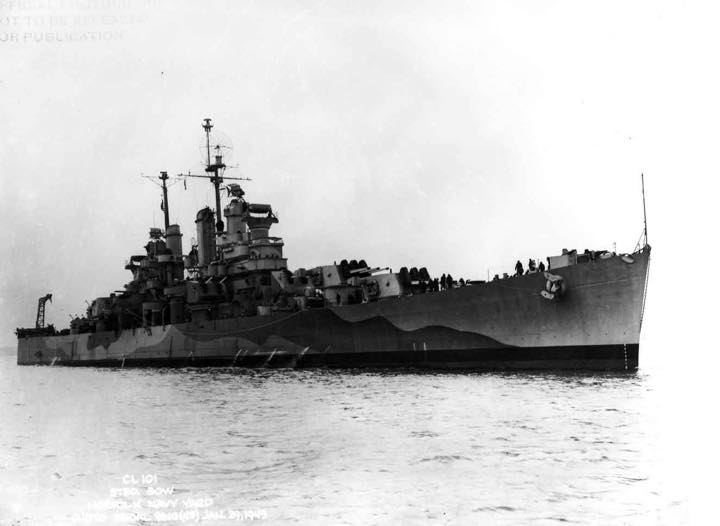Amersterdam CL-101

Amsterdam
A manufacturing city located in eastern New York, 28 miles northwest of Albany.
__________
Amsterdam (CL-59)—whose name was personally chosen by President Franklin D. Roosevelt on 2 August 1940 for this projected Cleveland-class light cruiser—was laid down on 1 May 1941 at Camden, N.J., by the New York Shipbuilding Corp. However, prior to her completion, the warship was converted to an aircraft carrier; renamed Independence (CV-22) (q.v.) on 12 February 1942; and was launched under the new name on 22 August 1942.
I
(CL-101: dp. 10,000; 1. 610'1"; b. 66'4"; dr. 24'; s. 31.6 k.; cpl. 1,426; a. 12 6", 12 5", 28 40mm., 10 20mm.; cl. Cleveland)
Amsterdam (CL-101) was laid down on 3 March 1943 at Newport News, Va., by the Newport News Shipbuilding and Dry-dock Co.; launched on 25 April 1944, sponsored by Mrs. William E. Hasenfuss, the first "Gold Star Mother" of Amsterdam, N.Y., who had lost a son in the Japanese attack on Pearl Harbor on 7 December 1941; and commissioned at the Norfolk Navy Yard, Portsmouth, Va., on 8 January 1945, Capt. Andrew P. Lawton in command.
After final fitting out at Norfolk, the light cruiser got underway on 5 February for shakedown training in the Chesapeake Bay. On 17 February, she stood out from Hampton Roads and headed south for Trinidad, British West Indies, and the second phase of her shakedown cruise. Amsterdam operated from Trinidad through 13 March, when she set a course for Norfolk. During the return voyage, she held shore bombardment practice off the island of Culebra and then arrived back at Norfolk on the 20th. Following a short cruise to Cape May, N.J., for gunnery exercises, the ship entered the Norfolk Navy Yard on 24 March for availability.
Amsterdam left the yard on 20 April for training exercises in Chesapeake Bay and, four days later, sailed for the Caribbean. She held training exercises off Culebra and at Guantanamo Bay, Cuba, and then proceeded to the Panama Canal which she transited on 5 May. The warship reached Pearl Harbor on 18 May and, during her stay in Hawaiian waters, carried out numerous gunnery and tactical exercises.
On 9 June, the cruiser set a course for Leyte, Philippine Islands. Upon her arrival in San Pedro Bay on the 21st, she reported to the 3d Fleet for duty. After a period of provisioning and refueling, the ship sortied on 1 July with Task Force (TF) 38 to cover air strikes against the Japanese home islands. On 10 July, the force's planes began a series of raids on Japanese airfields, factories, and shipping. During these actions, Amsterdam protected the carriers from attack by enemy air or surface forces. Among the cities the task force attacked were Tokyo, Kure, Kobe, and Osaka. On 15 August, TF 38 was preparing to launch another attack on Tokyo when its ships received word of Japan's capitulation.
During the next few weeks, Amsterdam remained in waters off the east coast of Honshu guarding against possible Japanese aggression during armistice negotiations. She steamed into Tokyo Bay on 5 September and remained there through the 20th and then shaped a course for the United States. After brief layovers at Buckner Bay, Okinawa, and Pearl Harbor to take on personnel for transportation to the United States, the cruiser arrived at Portland, Oreg., on 15 October and remained at that port for a fortnight to participate in Navy Day ceremonies. On the 29th, she got underway for San Pedro, Calif.
The ship reached San Pedro on 1 November. After a period of leave and upkeep, the cruiser left the west coast on 19 November bound for Pearl Harbor. She touched there on the 25th and took on personnel and equipment for transportation to the west coast. The cruiser set sail again on 12 December, arrived back at San Pedro on the 18th, and rode at anchor there into early 1946. On 21 January, she got underway for San Francisco. Shortly after her arrival, her crew began work to prepare the ship for inactivation and entry into the Pacific Reserve Fleet. She was decommissioned on 30 June 1947 and was laid up at San Francisco. Amsterdam's name was struck from the Navy list on 2 January 1971, and the vessel was sold on 11 February 1972 to National Metal & Steel Corp., Terminal Island, Calif., and later scrapped.
Amsterdam earned one battle star for her World War II service
 >
>